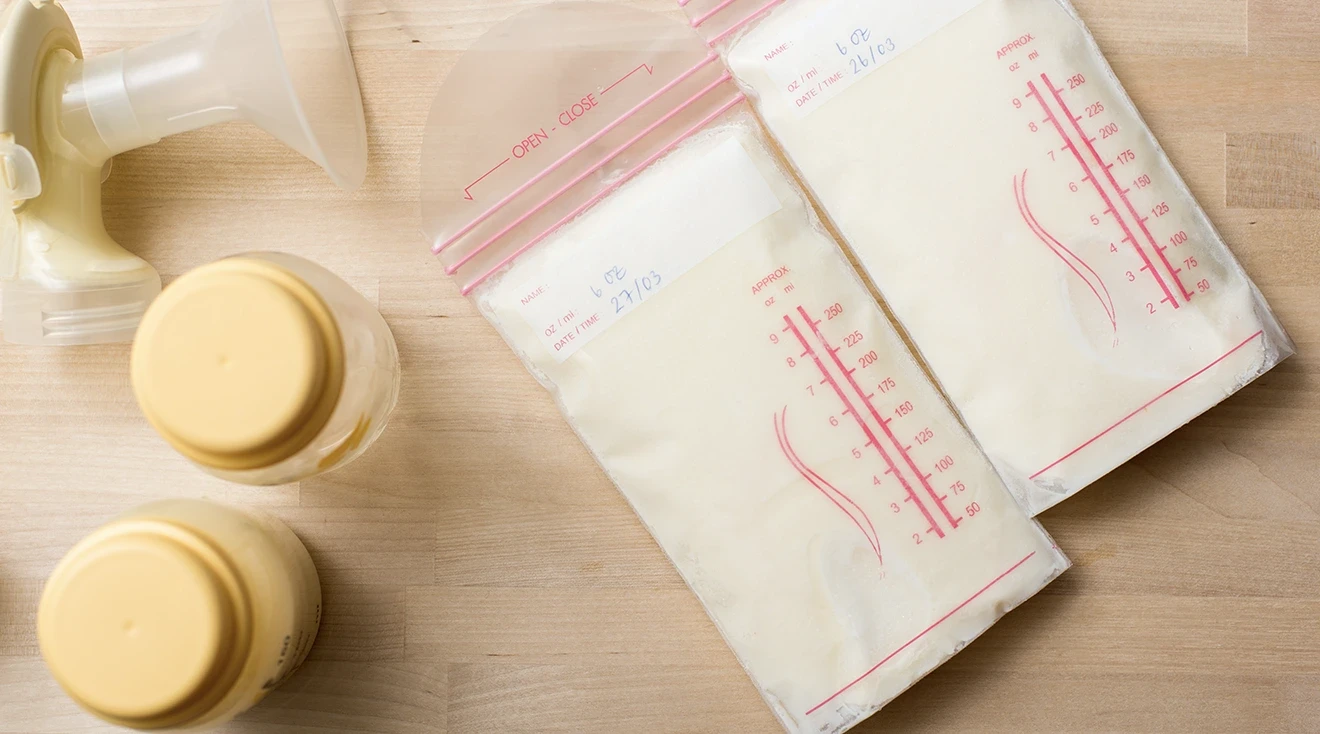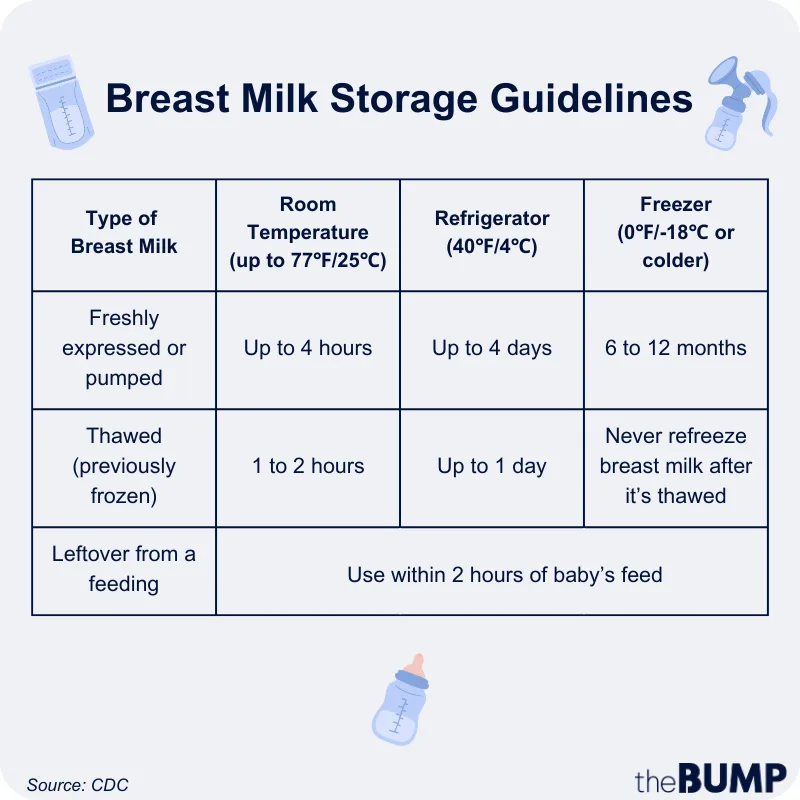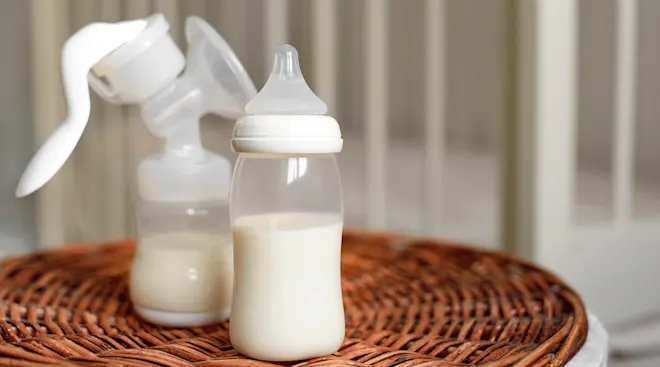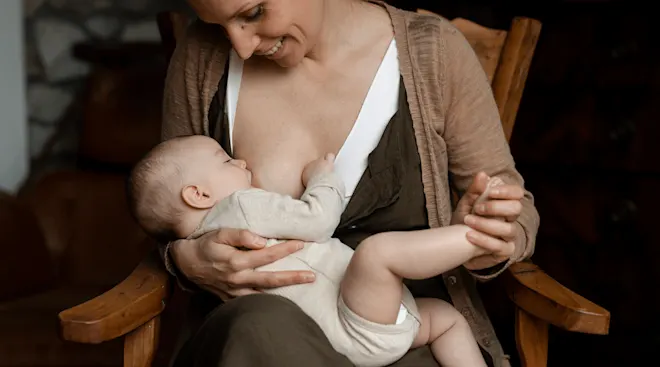The Dos and Don’ts of Breast Milk Storage
Whether you’re heading back to work or just looking to introduce baby to bottles, pumping is a great option for moms who want to provide breast milk but can’t always nurse. Of course, storing breast milk creates a whole new avenue of work—and it can be a bit confusing at first. What container you use, where you place it, what temperature you keep it at and how long it stays out can impact the safety and nutritional value of your breast milk. Being smart about breast milk storage can be somewhat of a science, but it doesn’t have to be difficult. Read on to learn from experts how to store breast milk safely to preserve the fruits of your labor.
- Breast milk can be stored at room temperature (up to 77 degrees Fahrenheit) for up to four hours, in the fridge for up to four days and in a normal kitchen freezer for up to six months.
- To warm breast milk, hold the bag or container under warm running water, place it into a bowl of warm water or use a bottle warmer. Never heat it in a microwave or over a stovetop. To thaw breast milk, place it in the fridge overnight.
- To prevent bacterial contamination, it’s best to reheat breast milk only once and discard anything baby doesn’t finish.
- You’ll be able to tell the breast milk has gone bad if it appears stringy or mucusy, or if it has a foul, rancid odor (similar to spoiled cow’s milk).
Breast milk is like liquid gold, so it’s understandable to want to make use of every ounce you pump. One of the most frequently asked questions when it comes to breast milk storage: How long is breast milk good for? After all, keeping it fresh is key. To learn how to store breast milk properly and protect it from spoiling, check out the following breast milk storage guidelines chart, which includes how long it can stay out and at what temperature. Keep in mind that this breast milk storage chart, based on information from the Centers for Disease Control and Prevention (CDC), should only be used for healthy, full-term infants. Talk to your pediatrician about storing breast milk for premature infants, as they have much more sensitive immune systems and may be more prone to infections.
Read on for more important breast milk storage tips and tricks, based on your chosen storage method.
New parents are busy—you may finish feeding baby, place their half-finished bottle on the counter and get swept up in another task, like burping baby or changing their diaper. So how long can breast milk stay out at room temperature? According to the CDC’s breast milk storage guidelines and Jessica Madden, MD, IBCLC, freshly pumped milk can stay out at room temperature for up to four hours. You’ll want to place it in the coolest spot you can find and keep it away from direct sunlight. Don’t store breast milk for any amount of time at temperatures higher than 77 degrees Fahrenheit, due to the risk of bacteria growth.
Now that you know how long breast milk lasts on the counter, you may wonder: How long does breast milk last in the fridge and freezer? When it comes to storing breast milk, use the fridge for short-term breast milk storage and the freezer for long-term storage. So how long does breast milk last in the fridge? It’s best to use refrigerated breast milk within 24 hours for ideal freshness, but properly stored milk can last up to four days. After four days, it begins to lose its antibody content, Madden says, making it easier for bacteria to grow and the milk less nutritional for baby. A good rule of thumb: If you’re planning to use your expressed milk pretty soon, keep it in the refrigerator so you don’t have to worry about thawing it. Below, some tips for how to store breast milk in the fridge:
Have the right location
The real estate you carve out for breast milk storage matters, especially in the refrigerator. Always place freshly pumped milk in the back center of the fridge, since this is the coldest area, notes the Mayo Clinic. Never store breast milk in the fridge door, as the temperatures fluctuate every time it’s opened or closed.
Use quality storage containers
For the fridge, use breast milk storage containers, such as screw-cap bottles, hard plastic cups with tight caps or heavy-duty breast milk storage bags. “Make sure the bags aren’t filled [beyond] the measurement indicator line, seal the bag tightly and place in a food storage container to keep it away from meats [and other uncooked foods to avoid contamination],” says Tamara Hawkins, FNP, RN, IBCLC. What’s not recommended: regular plastic storage bags—they can easily leak or spill.
Mixing from several pumping sessions is okay
Sometimes you just don’t get enough milk from a single pumping session. So can you add fresh breast milk to refrigerated breast milk? Answer: Yes! It’s okay to combine pumped milk from several sessions with one caveat: Always chill the new milk before adding it to the old. “When you mix milks that are two different temperatures—for example, combining a bottle in the fridge with freshly pumped milk and then putting it back in the fridge—the cold milk will get warmer, then colder again and then rewarmed when given to baby,” explains Regina Eichenberger, PA-C, IBCLC, a board-certified lactation consultant at Boston Children’s Health Physicians. Instead, combine the milks when they’ve both been sitting in the fridge for a few hours. If you won’t be using the milk immediately, label it using the date of the older milk and move it to the freezer. Note that it’s never safe to add fresh breast milk to frozen breast milk. “The fresh milk, since it’s warmer, may actually thaw some of the frozen milk, which may lead to storing spoiled milk,” says Nancy Clark, IBCLC, a lactation consultant in the DC area.
How to warm up breast milk?
The last thing you want to do when baby is wanting to be fed is wait for milk to warm up—but it’s quicker than you think! Gently swirl (if it’s in a bottle) or massage (if it’s in a bag) the milk while you hold it under warm, running water for several minutes. You can also fill a bowl with warm water and let the milk heat up, the CDC says. (Just be sure to use warm, not hot water so the milk doesn’t overheat.) Another option for how to warm up breast milk is to use a bottle warmer. Again, stay away from the stove and microwave—the uneven heating could easily scald baby or damage the milk, Clark says. Regardless of the warming method you choose, always make sure the milk is just the right temperature for baby; test a drop on the inside of your forearm—it should feel warm, not hot.
Can warmed breast milk be refrigerated again?
Wondering if you can reheat any milk baby didn’t finish? “Breast milk should be warmed only once,” Eichenberger says. “Rewarming breast milk more than once increases the risk of bacteria growth.”
But can warmed breast milk be refrigerated again? The answer is yes—feed baby unused milk at the very next feeding, but keep it chilled rather than rewarming it. (The CDC says breast milk can be served at room temp or cold.)
As you start to build up a stash, you’ll need to claim some space in the freezer for breast milk storage. If you don’t think you’ll use your freshly pumped breast milk within four days, freezing it can be a smart way to preserve some of the nutrients. While it won’t be quite as nutrient-dense as the fresh stuff (freezing breast milk reduces some of its natural vitamins, including important antioxidants), it’ll stay fresh enough for many months in the freezer, as long as it’s stored properly.
Exactly how long does frozen breast milk last? According to CDC guidelines, breast milk can be stored in the freezer for up to 12 months, although it’s best to use it within six months. “Pumped breast milk can be frozen for up to six months in a normal kitchen freezer and for 9 to 12 months in a deep freezer,” Madden adds. Here are some important tips for freezing breast milk to ensure it stays safe for baby.
- Use freezer-safe containers. When freezing breast milk, use a glass or BPA-free plastic container that seals tightly and is freezer-grade. That can include glass jars with screw caps or hard plastic containers with snap tops. Breast milk storage bags can be used for freezer storage but won’t keep milk protected for as long as sealed containers. “The bag may leak or spill and can become contaminated more easily than a hard container,” Hawkins says. Be sure to leave an inch of space at the top, since breast milk expands when frozen.
- Label each container. Be sure to mark each container or bag with the date the milk was expressed, and always use the oldest milk first.
- Find the coldest spot in the freezer. “Be smart about where you place the milk. In the back center of the freezer, temperatures will be the coldest and most constant,” Eichenberger says. “Avoid putting milk in the freezer door. Since the door is constantly being opened and closed, the temperature is more likely to be variable.”
How long is thawed breast milk good for?
After freezing breast milk, you’ve got to reheat it once you’re ready to use it. But how long is thawed breast milk good for and can it be re-stored? If baby only drinks part of a bottle of thawed milk, you can only store the remaining milk for about an hour or two in the fridge before discarding. Never refreeze or reheat breast milk that’s been thawed, the CDC notes. If you’re not feeding baby immediately, keep defrosted breast milk in the fridge. If you thawed it at room temperature, the milk is good for up to two hours (after that, throw it out). If you thawed it in the fridge, it can be used for up to 24 hours.
Wondering how to thaw breast milk? There are several ways to go about defrosting breast milk—but the microwave isn’t one of them. “Doing so can kill all the breast milk’s living immune properties and create hot spots that can potentially burn baby’s mouth or throat,” Hawkins says. Heating breast milk directly on a stove should also be avoided (there’s one exception to this rule—more on this below!).
The best way to thaw frozen breast milk is to leave it in the refrigerator overnight. “If a rush defrost is needed, place the container of breast milk in a bowl of warm water, making sure the water doesn’t rise above the rim of the bottle,” Hawkins says. Admittedly, defrosting frozen breast milk can be time consuming, so plan ahead and always keep some breast milk in the fridge to have on hand.
As eager as you may be to use up all your pumped breast milk, you also want to be sure the milk you feed baby is fresh and safe to drink. So how can you spot spoiled breast milk? It’s actually not all that different from determining spoiled cow’s milk with a quick visual and smell test.
When chilled, your breast milk will naturally separate into layers, with the fat rising to the top. The milk should easily mix after you swirl it around; if you still see separated clumps, it could be a sign the breast milk has gone bad. “You’ll know if the milk is absolutely bad because it’ll appear stringy, mucusy or will look as though there’s pus in the milk,” Hawkins explains. You can also give the milk in question a smell. Spoiled milk will have that rancid, foul odor that’s hard to mistake, similar to cow’s milk that’s past its prime. Still not sure? Perhaps the easiest way to detect spoiled breast milk is to taste it, Hawkins adds. Spoiled breast milk will have that unmistakable sour taste.
Lipase in breast milk
Occasionally, some moms may detect a sour or soapy smell from their breast milk after it’s been freshly pumped or stored in the fridge or freezer—but it doesn’t mean the milk has gone bad, Hawkins says. It could simply be a sign that your milk has high levels of lipase, an enzyme that helps baby easily digest the fat in your breast milk and absorb essential fatty acids like DHA.
Why do some moms produce more lipase? According to Ashley Georgakopoulos, IBCLC, medical advisor with Motif Medical, it could be due to chronic health issues that cause different types of inflammation, like acute pancreatitis and diabetic ketoacidosis, but may also simply be a result of Mom’s stress or nutrition levels. That said, having a lot of lipase in breast milk isn’t necessarily a problem. “Many babies are unbothered by this,” Hawkins says. “They drink the milk without any hesitation and there’s nothing to worry about. The milk is still good.” But other babies might not appreciate the odor and refuse to drink your milk after it’s been stored. Luckily, heating freshly pumped milk to a high temperature can tamp down on the lipase activity and get rid of that sour or soapy smell.
When scalding breast milk, place it on the stove (never the microwave) and keep a careful eye on it—you don’t want the milk to reach a boil, Hawkins cautions. Instead, you’re aiming to heat the milk to 144 Fahrenheit for one minute. You can use a food thermometer to know when you’ve reached the right temp, or simply keep the milk over heat until you spot small bubbles rising along the edges of the pan. Once the milk is ready, take the pan off the stove and sit it in a bowl of ice water to cool down rapidly. You can then store your cooled milk as you would normally in the fridge or freezer. Wondering how to heat up breast milk that’s been scalded? Georgakopoulos says you can also reheat as you normally would. “Slight changes in the nutritional state may occur, with the double process, but when done properly, the changes should be insignificant,” she notes, adding that parents should be extra cautious with the shelf-life of the milk due to an increased risk of bacteria. “All thawed milk needs to be used within 24 hours, regardless of scalding or heat-treating,” she adds.
There are a few things to keep in mind when it comes to breast milk storage. Here are some general tips from the CDC:
Wash your hands
To ensure the breast milk baby consumes is safe and hygienic, wash your hands with soap prior to pumping or expressing by hand. Make sure all the parts of your breast pump are clean.
Pick the right breast milk storage containers
As noted, you want to use quality breast milk storage containers. That means fridge- and freezer-safe bags and individual containers that won’t leak, have room for any expansion as the milk freezes and will tightly seal to avoid bacterial contamination. “I recommend choosing containers that are made for storing breastmilk—meaning they’re sterile, easy to seal up, leak-proof and clearly labeled with markers to show the volume of milk in each container,” Madden says.
Store milk in small batches and label it clearly
Just like most other food, once breast milk is thawed, it shouldn’t be rewarmed or refrozen. To avoid wasting unused milk, store it in small batches of 2 to 4 ounces, and label with the date it was expressed. This way, it’s easy to heat up more milk if baby is still hungry, but eliminates the potential for waste. And if you think baby won’t drink any freshly expressed breast milk within four days, the CDC recommends freezing it right away to protect the quality.
Communicate with any childcare providers
If you’re planning to hand the breast milk off to another childcare provider, ensure the container is also clearly labeled with baby’s name. Moreover, communicate any requirements for heating and storing breast milk.
Be smart about breast milk storage while traveling
According to the CDC, you can safely store breast milk in an insulated cooler for up to 24 hours. Keep ice packs on the milk container at all times, and don’t open the cooler bag unless you absolutely have to. Once you get to your destination, either use the milk immediately, refrigerate it or freeze it.
Know nutritional values
All three methods of storing breast milk—keeping it at room temperature for four hours, refrigerating it or freezing it—are safe and can be used to create your supply. However, there are some minor nutritional discrepancies to be aware of. Freshly pumped breast milk will have the best nutritional quality, but will spoil the fastest. Meanwhile, refrigerated breast milk usually has less fat loss and retains more protective qualities than frozen milk, according to La Leche League International. However, that doesn’t mean one way is better than the other—there are still merits to storing breast milk in the fridge or freezer. You have to do what’s best for your situation.
Frequently Asked Questions
What is the pitcher method for storing breast milk?
According to Madden, the pitcher method pools together all milk that’s been pumped into a 24-hour period into one container. “In most cases, this milk is fed to baby the next day,” she explains. But if you do use this method, freeze any breast milk that’s left over to avoid having any new milk mixed in with the old milk.
Can you reheat breast milk twice?
It’s best to only heat breast milk once and avoid reheating it twice. This is to prevent excessive bacterial growth, which can happen when you reheat breast milk more than once, Madden says.
How long can warmed breast milk sit out?
“Breast milk should be consumed within two hours of being prepared and warmed,” Madden says.
How long is breast milk good for after pumping?
According to Madden, after pumping, breast milk can sit out at room temperature (up to 77 degrees Fahrenheit) for around four hours, last in the fridge for up to four days, last in a normal kitchen freezer for up to six months and in a deep freezer for up to a year.
How long is defrosted breast milk good for in the fridge?
According to Madden, breast milk that has been thawed in the fridge should be consumed within 24 hours. This is “due to a marked decrease in antibacterial (bacteria-fighting) properties,” she explains, which leaves more room for bacteria to grow.
Should you store breast milk in baby bottles?
While you can store breast milk in plastic or glass baby bottles, Madden’s preference is to store it in tightly-sealed, individual containers to prevent contamination. “If you do opt to store milk in plastic baby bottles, it’s important to make sure they do not contain a chemical called bisphenol-A (BPA),” she adds. “BPA is associated with reproductive and immune system problems.”
Learning how to properly store breast milk can be a bit of a learning curve, but rest assured you’ll get the hang of it in no time. Follow the rules above for how long breast milk can stay out, in the fridge and in the freezer, as well as for how to store reheated breast milk, to ensure baby gets the freshest milk possible. And if you ever find yourself with any questions or concerns, don’t hesitate to reach out to your medical provider or a lactation consultant.
Please note: The Bump and the materials and information it contains are not intended to, and do not constitute, medical or other health advice or diagnosis and should not be used as such. You should always consult with a qualified physician or health professional about your specific circumstances.
Plus, more from The Bump:
Nancy Clark, IBCLC, a lactation consultant in the DC area. Having received her IBCLC certification in 1989, she has over 30 years of experience as a lactation consultant and also became a certified lamaze childbirth educator in 2006. In her spare time, she volunteers on the program board for the DC area March of Dimes. She earned her bachelor of science degree from Georgetown University.
Regina Eichenberger, PA-C, IBCLC, is a board-certified lactation consultant at Boston Children's Health Physicians. She earned her bachelor’s degree from Stanford University and a master’s degree in public health from the University of Michigan. She earned her physician’s assistant certification from Baylor College of Medicine.
Ashley Georgakopoulos, IBCLC, has eight years of experience in lactation counseling and currently serves as a medical advisor with Motif Medical. She received her bachelor’s degree in nutrition sciences from the University of Tennessee-Knoxville.
Tamara Hawkins, RN, NP-C, IBCLC, LCCE, CHHC, is a lactation consultant in New York City. She earned her bachelor’s nursing degree at New York University and master's nursing degree at SUNY Downstate Medical Center. Hawkins completed her IBCLC certification in 2004.
Jessica Madden, MD, IBCLC, is a board-certified pediatrician, lactation consultant and neonatologist at Rainbow Babies and Children’s Hospital in Cleveland, Ohio. She also currently serves as the medical director of Aeroflow Breastpumps, as well as the founder of Primrose Newborn Care. Previously, she has served as the clinical instructor of pediatrics at Harvard Medical School. She received her bachelor’s degree from the University of Notre Dame and her medical degree from Ohio State University. She completed her residency in pediatrics at the University of Massachusetts.
Centers for Disease Control and Prevention, Proper Storage and Preparation of Breast Milk, January 2022
Mayo Clinic, Breast Milk Storage: Do’s and Don’t’s, April 2022
Centers for Disease Control and Prevention, How to Keep Your Breast Pump Clean, February 2023
La Leche League International, Storing Human Milk
Journal of Health, Population and Nutrition, Total Antioxidant Concentrations of Breastmilk—An Eye-Opener to the Negligent, December 2011
La Leche League, Milk Issues: Soapy, Metallic, Sour, or Spoiled Milk?
Learn how we ensure the accuracy of our content through our editorial and medical review process.
Navigate forward to interact with the calendar and select a date. Press the question mark key to get the keyboard shortcuts for changing dates.























































